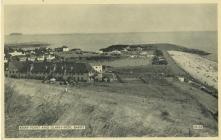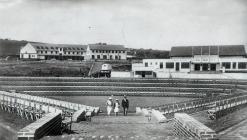Gellir lawrlwytho cynnwys at ddefnydd anfasnachol, megis defnydd personol neu ar gyfer adnoddau addysgol.
Ar gyfer defnydd masnachol cysyllwch yn uniongyrchol gyda deilydd yr hawlfraint os gwelwch yn dda.
Read more about the The Creative Archive Licence.
Disgrifiad
Dyddiad: 29 Ebrill 1918
Trawsysgrif:
[1]
SHIP SUNK BY TORPEDO, 57 Y. M. C. A. WORKERS SURVIVE
[...]
Convoyed Ship Sunk by U-Boat 247 Are Saved
All Americans Escape Almost Without Baggage After Night Attack—Vessel Goes Down in Twelve Minutes—Praised for Coolness.
LONDON, Monday.—Fifty-seven American Y. M. C. A. war workers, under Arthur E. Hungerford, who were aboard a steamship which was torpedoed Sunday morning, sinking in twelve minutes, arrived in London Sunday night. The vessel was struck amidships while proceeding in a large convoy under the protection of destroyers. All passengers were saved by destroyers. There were about 250 persons on board.
At the time she was torpedoed the steamship was proceeding at about ten knots in bright moonlight. There was immediately a heavy list and three minutes later the boilers blew up, extinguishing the lights all over the vessel.
All except three of the crew were saved. The destroyers within half an hour picked up all the lifeboats. The Americans are all well and safe, although they saved only a little clothing and no
baggage.
One of the ship’s officers told the Associated Press that the Americans had conducted themselves in an admirable manner. They had spent most of their time aboard in military drills and day and night lifeboat drills. Every man knew his station and in the brief time afforded them all the lifeboats were launched successfully.
"The Americans behaved like veterans and were of the greatest assistance in launching the lifeboats and handling them," said one of the ship’s officers.
On their arrival in London the Americans were taken in charge by the American Y. M. C. A. and Red Cross.
Two of the crew who lost their lives were caught below and went down with the ship. The third man was the ship’s baker, who after reaching his lifeboat station went back for his money belt.
The discipline on board the ship was excellent. Although the time was brief, all the boats were launched successfully. Several of the Americans lost their passports and all their money.
The steamship which was sunk in English waters while carrying fifty-seven Young Men's Christian Asosciation [sic] workers was the British steamship Orissa [sic], it was learned here to-day. The workers for the Young Men's Christian Association were on their way to France and were in charge of Arthur F. Hungerford, formerly a nefspaper [sic] man of Baltimore, who was on his way to France on a special Y. M. C. A. mission.
The Orissa [sic] was built, in Sunderland. England, in 1897, and was of 5,436 tons gross. She left an American port on April 12 bound for a European port. She was 410 feet long, fifty feet, beam and twenty-nine feet in depth, and was owned by the British India Steamship Company.
[2]
57 Y. M. C. A. WORKERS RESCUED AS TORPEDO SINKS CONVOYED SHIP
The- Orissa [sic], Which Left an American Port on April 12, Goes to Bottom Twelve Minutes After U-Boat Attack.
(Continued from First Page.)
and went down with the ship. Another went below to get his money belt and was never seen again. The discipline on board the ship was excellent. Although the time was brief, all the boats were launched successfully. Several of the Americans lost their passports and all their money.
The submarine was not seen at the time the vessel was torpedoed, but several of the survivors told a story of a periscope appearing for a moment in the midst of the lifeboats.
"It was said the periscope was seen from nearby torpedo boat destroyers, which, however, did not dare fire for fear of hitting the lifeboats," said the Rev. Charles Vickery, of Salina, Kansas. "If the periscope did appear it was only for a brief moment. While the lifeboats were being picked up one American and one British destroyer circled the spot, dropping several depth charges."
Gale Seeman, of Los Angeles, and E. C. Pullen, of New York State, had narrow escapes in getting into lifeboats. Each of them caught his feet in one of the ropes with which his boat, was being lowered. Mr. Seeman was thriwn [sic] into the water head down, with his feet entangled, but was saved by Robert Peckham, of Springfield, Mass., who cut the rope and dragged Hr. [sic] Seeman into the lifeboat as it was pulling away. Mr. Pullen was able to get clear of the rope by his own efforts.
Among the other passengers Mr. and Mrs. Thomas Thring had the most exciting experience. Mr. Thring is an Australian who was invalided from the British army several months ago, after two years of fighting in Africa and at Gallipdli. He went to Australia where he was married, and was returning to England with his bride to settle the estates of two brothers who were killed recently in France.
The torpedo struck just beneath the cabin in which Mr. and Mrs. Thring were. They were thrown from their berth and injured severely. The stateroom door was jammed so that it could not be opened. Mr. Thring broke the partition and carried his unconscious wife to the deck, where he, too, fell unconscious. Both were carried to a lifeboat, by A. H. Rogue, a Y. M. C. A. man from Highland Park, Ill.
After being taken aboard the destroyers the survivors had a trip
of five hours to port, where a crowd gathered at the pier to meet them.
"There was a long delay in getting our destroyer into her berth," said the Rev. H. S. Mallison, of Flint, Mich. "l suggested to the men that we gather at the bow and show we were in good spirits by singing. We sang 'The Star Spangled Banner,' 'God Save the King' and 'Onward, Christian Soldiers,' and the crowd on shore cheered.
"I noticed an elderly man in military uniform standing apart on the pier, who seemed to be affected deeply by our singing. When we got ashore I was not surprised to see him take charge of us, line us up in military fashion and then shake hands with each one of us and congratulate us. He was Viscount French (Commander of the Home Forces), who happened to be in port. Hearing that some American survivors were coming in he insisted on going down to greet them personally."
Lost Ship Was the Orissa [sic], Which Left U. S. April 12
The steamship which was sunk in English waters while carrying fifty-seven Young Men's Christian Association workers was the British steamship Orissa [sic], it was learned here to-day. The workers for the Young Men's Christian Association were on their way to France and were in charge of Arthur F. Hungerford, formerly a newspaper man of Baltimore, who was on his way to France on a special Y. M. C. A. mission.
The Orissa [sic] was built, in Sunderland. England, in 1897, and was of 5,436 tons gross. She left an American port on April 12 bound for a European port. She was 410 feet long, fifty feet, beam and twenty-nine feet in depth, and was owned by the British India Steamship Company.
Among the Americans is Harry Holmes, who has for many months represented the Y. M. C. A. with the Australian troops. Holmes received a leave of absence in February and returned to America to marry a Dayton (Ohio) girl. With his bride he was again on his way to France.
NAMES OF SURVIVORS.
The other workers on board the torpedoed vessel, according to a list, given out here to-day by the Y. M. C. A. War Work Council, follows:—
J. M. Armstrong, Lapeer, Mich.
Ralph C. Bennett, Chicago, Ill.
William Clayton Berry, Childress, Texas.
A. H. Bogue, Highland Park, Ill.
Theodore Ivan Bordwell, Warren, Pa.
J. F. M. Chambers, Evanston, Ill.
Philip Cook, Baltimore, Md.
Harvey E. Darr, Wooster, Ohio.
Thomas B. Dawson, Providence. R. I.
Samuel W. Downer. Downer. N. J.
William A. Eisenberger, Berwyn, Md.
Evore Evans, Honesdale, Pa.
Alfred H. Burney, Providence, R. I.
Victor Henry Gurney, Brighton. Mass.
James Harper Grier, Canonsburg, Pa.
Charles R. Gilmore, Tulsa, Okla.
Joseph M. M. Gray, Kansas City, Mo.
Schuyler F. Herron, Winchester, Mass.
Joseph H. Hefflon, Winchester, Mass.
A. P. Haigh, Waukegan, Ill.
Henry E. Hervig, Chicago, Ill.
Carleton C. Hutchins, Cleveland, Ohio.
Arthur E. Hungersford, Mount Washington, Md.
Percy E. Heartz, Fort Collins, Col.
George H. Hoyes, Topeka, Kan.
Henry S. Jewett, No. 14 East Thirty-eighth street, New York city. Reuben Monroe John, Indianapolis, Ind.
Frank E. Lahym, Traverse City, Mich.
Samuel Robb Leland, No. 901 Ogden avenue, the Bronx. N. Y. George H. Macrum, No. 121 East Twenty-third street, New York. Charles Wolcott Merriam, Grand Rapids, Mich.
Horace Horatio Mallinson, Flint, Mich.
James Garfield Murray, Indianapolis, Ind.
Edward Tilden Mathes, Bellingham, Wash.
Joseph Alderson Matthews, Hollywood, Cal.
Charles G. Noble. Indianapolis, Ind.
Isaac Edward Norris, Marion, Ind.
Samuel Nahas, Malden, Mass.
Charles H. Pearson, No. 265 West Eighty-first street, New York.
John Butler Pugsley, Brookline, Mass.
Ernest Clifford Pullen, Rhinebeck, N. Y.
Reuben Wallace Peckham, Springfield, Mass.
John Ruff, No. 23 South Elliott place, Booklyn, N. Y.
Charles P. Randall, Oak Park. Ill.
Frederick Foster Snow. Cumberland. Md.
Albert Noah Smith, Mankato, Kan.
George Henry Shafer, No. 3,044 Albany, Crescent, N. Y.
Gale Seaman, Los Angeles, Cal.
Donald J. Taylor, St. Helens, Oregon.
Frank Milford Van Epps.
Charles R. Vickery, Manlius, N. Y.
Harry Cowper White, Bound Brook, N. J.
Samuel Edwin Walker, East Northfield, Mass.
Albert Franklin Williams, Freeport, Ill.
Arthur Luke Wight, Malden, Mass.
George D. Whitehead, Bloomfield, N. J.
Robert Purdy, Zebley, Philadelphia, Pa.
Ffynhonnell:
World War history: daily records and comments as appeared in American and foreign newspapers, -1926. (New York, NY) 28 Ebr. 1918, pp. 75-6. O'r Library of Congress, www.loc.gov/item/2004540423/1918-04-28/ed-1/.








Oes gennych chi wybodaeth ychwanegol am yr eitem hon? Gadewch sylwad isod
Sylwadau (0)
Rhaid mewngofnodi i bostio sylw